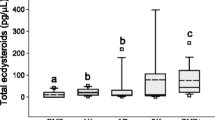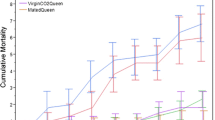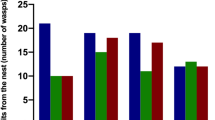Summary
Previous studies suggested that juvenile hormone (JH) is involved in the regulation of physiological processes that are associated with division of labor in honey bees but the effects of JH on behavior were not clear. The hypothesis that JH affects worker age polyethism was tested by observing individually marked bees topically treated with different doses of the JH analog methoprene. Methoprene caused dose-dependent changes in the timing and frequency of occurrence of four important age-dependent tasks: brood and queen care, food storage, nest maintenance, and foraging. Weak or no effects were observed for social interactions, self-grooming, and other non-task behaviors that were not performed in an age-dependent manner. These results support the hypothesis that JH is involved in the control of age polyethism. A model is presented that explains the role of JH in regulating division of labor. JH may regulate the colony's allocation of labor by altering the probabilities of response to tasks. According to this model, hormone titers increase with age according to a genetically determined pattern of development, but this rise may be modulated by environmental and colony factors such as food availability and population structure. Extrinsic regulation of JH may be a mechanism underlying the ability of workers to respond to changing colony needs.
Similar content being viewed by others
References
Altmann SA, Altmann J (1977) On the analysis of rates of behaviour. Anim Behav 25:364–372
Anderson RJ, Henrick CA, Sidall JB, Zurflüh R (1972) Stereoselective synthesis of the racemic C-17 juvenile hormone of Cecropia. J Am Chem Soc 94:5379–5386
Baker FC, Hagedorn HH, Schooley DA, Wheelock G (1983) Mosquito juvenile hormone: identification and bioassay activity. J Insect Physiol 29:465–470
Bergot BJ, Ratcliff MA, Schooley DA (1981) Method for quantitative determination of the four known juvenile hormones in insect tissue using gas chromatography-mass spectroscopy. J Chromat 204:231–244
Bigley WS, Vinson SB (1979) Degradation of [14C] methoprene in the Imported Fire Ant, Solenopsis invicta. Pest Biochem Physiol 10:1–13
Boch R, Shearer DA (1966) Iso-pentyl acetate in stings of honeybees of different ages. J Apicult Res 5:65–70
Boch R, Shearer DA (1967) 2-Heptanone and 10-hydroxy trans dec-2-enoic acid in the mandibular glands of worker honey bees of different ages. Z Vergl Physiol 54:1–11
Brouwers EVM (1983) Activation of the hypopharyngeal glands of honeybees in winter. J Apic Res 22:137–141
Bühler A, Lanzrein B, Wille H (1983) Influence of temperature and carbon dioxide concentration on juvenile hormone titre and dependent parameters of adult worker honey bees (Apis mellifera L.). J Insect Physiol 12:885–893
Calabi P, Traniello JFA, Werner MH (1983) Age polyethism: Its occurrence in the ant Pheidole hortensis, and some general considerations. Psyche 85:395–412
Crewe RM, Hastings H (1976) Production of pheromones by workers of Apis mellifera adansonii. J Apicult Res 15:149–154
Darroch JN (1959) The multiple-capture census II. Estimation when there is immigration or death. Biometrika 46:336–351
Fluri P, Lüscher M, Wille H, Gerig L (1982) Changes in weight of the pharyngeal gland and haemolymph titres of juvenile hormone, protein and vitellogenin in worker honey bees. J Insect Physiol 28:61–68
Free JB (1961) Hypopharyngeal gland development and division of labour in honey-bee (Apis mellifera L.) colonies. Proc R Entomol Soc Lond (A) 36:5–8
Free JB (1965) The allocation of duties among worker honeybees. Symp Zool Soc London 14:39–59
Hagenguth H, Rembold H (1978) Identification of juvenile hormone 3 as the only JH homolog in all developmental stages of the honey bee. Z Naturforsch 33c:847–850
Herbers JM, Cunningham M (1983) Social organization in Leptothorax longispinosus Mayr. Anim Behav 31:759–771
Hussein MH, Abdel-Aal YAI (1978) Effect of ZR-515 on honey bee, Apis melliferd. Z Angew Ent 87:109–111
Jaycox ER (1967) Behavioral changes in worker honey bees (Apis mellifera L.) after injection with synthetic juvenile hormone (Hymenoptera: Apidae). J Kans Entomol Soc 49:165–170
Jaycox ER, Skowronek W, Gwynn G (1974) Behavioral changes in a worker honey bee (Apis mellifera) induced by injections of a juvenile hormone mimic. Ann Entomol Soc Am 67:529–534
Kapil RP, Sihag RC (1981) Environmental interaction with endocrine functions in relation to the social activities of bees. Ind Bee J 43:64–66
Kolmes SA (1985) A quantitative study of the division of labour among worker honey bees. Z Tierpsychol 68:287–302
Lindauer M (1952) Ein Beitrag zur Frage der Arbeitsteilung im Bienenstaat. Z Vergl Physiol 34:299–345
Michener CD (1974) The social behavior of the bees: a comparative study. Belknap Press of Harvard University, Cambridge
Nijhout HF, Wheeler DE (1982) Juvenile hormone and the physiological basis of insect polymorphisms. Qu Rev Biol 57:109–133
Nowogrodzki R (1983) Individual differences and division of labor in honey bees. PhD Dissertation, Cornell University, Ithaca, NY
Oster GF, Wilson EO (1978) Caste and ecology in the social insects. Princeton University Press, Princeton
Rankin MA, Riddiford LA (1978) Significance of haemolymph juvenile hormone titre changes in timing of migration and reproduction in adult Oncolpeltus fasciatus. J Insect Physiol 24:31–38
Reeve HK, Gamboa GJ (1983) Colony activity integration in primitively eusocial wasps: the role of the queen (Polistes fascatus, Hymenoptera: Vaspidae). Behav Ecol Sociobiol 13:63–74
Ribbands CR (1953) The behaviour and social life of honeybees. Bee Research Association, London
Robinson GE (1985) Effects of a juvenile hormone analogue on honey bee foraging behaviour and alarm pheromone production. J Insect Physiol 31:277–282
Robinson GE (1986) Hormonal regulation of division of labor in honey bee (Apis mellifera L.) colonies. PhD Dissertation, Cornell University, Ithaca, NY
Robinson GE, Strambi A, Strambi C, Paulino-Simões ZL, Tozeto SO, Barbosa JMN (1987) Juvenile hormone titers in European and Africanized honey bees. Gen Comp Endocrinol (in press)
Rösch GA (1925) Untersuchungen über die Arbeitsteilung im Bienenstaat. I. Die Tätigkeiten im normalen Bienenstaate und ihre Beziehungen zum Alter der Arbeitsbienen. Z Vergl Physiol 2:571–631
Rösch GA (1927) Über die Bautätigkeit im Bienenvolk und das Alter der Baubienen. Weiterer Beitrag zur Frage nach der Arbeitsteilung im Bienenstaat. Z Vergl Physiol 6:265–298
Rösch GA (1930) Untersuchungen über die Arbeitsteilung im Bienenstaat. II. Die Tätigkeite der Arbeitsbienen unter experimentell veränderten Bedingungen. Z Vergl Physiol 12:1–71
Rutz W, Gerig L, Wille H, Lüscher M (1974) A bioassay for juvenile hormone (JH) effects of insect growth regulators (IGR) on adult worker honeybees. Mitt Schweiz Entomol Ges 47:307–313
Rutz W, Gerig L, Wile H, Lüscher M (1976) The function of juvenile hormone in adult worker honeybees, Apis mellifera. J Insect Physiol 22:1485–1491
Rutz W, Imboden H, Jaycox ER, Wille H, Gerig L, Lüscher M (1977) Juvenile hormone and polyethism in adult worker honeybees (Apis mellifera). Proc 8th Cong IUSSI, Wageningen, Holland, pp 26–27
Sasagawa H, Sasaki M, Okada I (1986) Experimental induction of the division of labor in worker Apis mellifera L. by juvenile hormone (JH) and its analog. 30th Int Cong Apimondia, Nagoya, Japan, pp 140–143
Sakagami SF (1953) Untersuchungen über die Arbeitsteilung in einem Zwergvolk der Honigbienen. Beiträge zur Biologie des Bienenvolkes, Apis mellifera L., I. Jap J Zool 11:117–185
Seeley TD (1979) Queen substance dispersal by messenger workers in honeybee colonies. Behav Ecol Sociobiol 5:391–415
Seeley TD (1982) Adaptive significance of the age polyethism schedule in honeybee colonies. Behav Ecol Sociobiol 11:287–293
Seeley TD (1985) Honeybee ecology: a study of adaptation in social life. Princeton University Press, Princeton
Seeley TD (1986) Social foraging by honeybees: how colonies allocate foragers among patches of flowers. Behav Ecol Sociobiol 19:343–354
Seeley TD, Morse RA (1976) The nest of the honey bee (Apis mellifera). Insectes Soc 23:495–512
Sekiguchi K, Sakagami SF (1966) Structure of foraging population and related problems in the honey bee, with considerations on the division of labour in bee colonies. Hokkaido Natn Agric Exp Stn Rep 69:1–65
Staal GB (1975) Insect growth regulators with juvenile hormone activity. Ann Rev Entomol 20:417–460
Strambi C, Strambi A, De Reggi ML, Hirn MH, Delaage MA (1981) Radioimmunoassay of insect juvenile hormones and their diol derivatives. Eur J Biochem 118:401–406
Tauber MJ, Tauber CA, Masaki S (1986) Seasonal adaptations of insects. Oxford University Press, New York
Tobe SS, Stay B (1979) Modulation of juvenile hormone synthesis by an analogue in the cockroach. Nature 281:481–482
Truman JW, Riddiford LM (1974) Hormonal mechanisms underlying insect behaviour. In: Treherne JE, Berridge MJ, Wigglesworth VB (eds) Advances in insect physiology. Vol 10, Academic Press, New York
Weaver RJ (1984) Effects of food and water availability, and of NCA-1 section, upon juvenile hormone biosynthesis and oöcyte development in adult female Periplaneta americana. J Insect Physiol 30:831–838
Weirich G, Wren J (1973) The substrate specificity of juvenile hormone esterase from Manduca sexta haemolymph. Life Sci 13:213–226
Wilson EO (1971) The insect societies. Belknap Press of Harvard University, Cambridge
Wilson EO (1976) Behavioral discretization and the number of castes in an ant species. Behav Ecol Sociobiol 1:141–154
Wilson EO (1983) Caste and division of labor in leaf-cutter ants (Hymenoptera: Formicidae: Atta). III. Ergonomic resiliency in foraging by A. cephalotes. Behav Ecol Sociobiol 14:47–54
Wilson EO (1984) The relation between caste ratios and division of labor in the ant genus Pheidole (Hymenoptera: Formicidae). Behav Ecol Sociobiol 16:89–98
Wilson EO (1985) The sociogenesis of insect colonies. Science 228:1489–1495
Winston ML (1987) Honey bee biology. Harvard University Press, Cambridge. (In press)
Zdárek J, Haragsim O (1974) Action of juvenoids on metamorphosis of the honey-bee, Apis mellifera. J Insect Physiol 20:209–221
Author information
Authors and Affiliations
Rights and permissions
About this article
Cite this article
Robinson, G.E. Regulation of honey bee age polyethism by juvenile hormone. Behav Ecol Sociobiol 20, 329–338 (1987). https://doi.org/10.1007/BF00300679
Received:
Accepted:
Issue Date:
DOI: https://doi.org/10.1007/BF00300679




